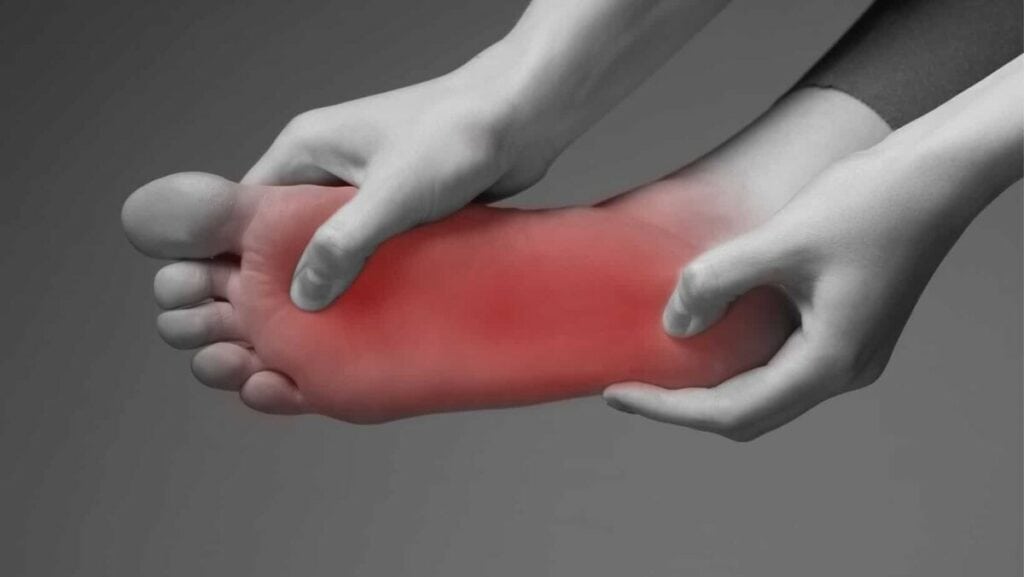Signs Plantar Fasciitis is Healing
- Outside Ankle Pain: Running, Standing, Walking - February 14, 2024
- Plantar Fasciitis Taping - January 30, 2024
- Peroneal Tendonitis Taping - January 30, 2024
Plantar Fasciitis is one of the most common forms of foot pain, accounting for 11-15% of all foot complaints that require medical intervention. The Plantar Fascia attaches the heel bone to the forefoot and plays an integral role in the structural stability of the foot’s medial arch.
If the Plantar Fascia becomes overloaded, it can become inflamed and painful, leading to Plantar Fasciitis. In cases where individuals continue to overload Plantar Fasciitis, it can become so bad that you can’t walk on it. We have written on the best treatment for Plantar Fasciitis, which we have linked below, but what are the signs that Plantar Fasciitis is Healing?
Related: Our Free PDF on the Best Exercises for Plantar Fasciitis
4 Signs Plantar Fasciitis is Healing
1: Consistent levels of pain
The Cycle of Pain and Activity
It is common for those with Plantar Fasciitis to experience a pattern of peaks and troughs. On days when pain levels are relatively low or manageable, patients often feel motivated to increase their activity level, thinking they are on the mend.
Unfortunately, this increase in activity can lead to a subsequent spike in pain, sometimes even worse than before.
Consistency as a Positive Sign
When fluctuations in pain levels begin stabilising, this is a good sign that your Plantar Fasciitis is beginning to heal.
When patients experience consistency in their plain levels, it often suggests that the plantar fascia is becoming more resilient and can handle more strain without inflaming.
Why Consistency Matters
Consistent pain levels are beneficial for rehabilitating plantar fasciitis as they reduce inflammation levels in the tissue, allowing for strengthening exercises.
Plantar Fasciitis rehabilitation exercises aim to stimulate the tissue. If these exercises are performed on irritated tissue, they can worsen Plantar Fasciitis symptoms, whereas exercises with low-level pain are the key to healing Plantar Fasciitis.
2: Less pain in the morning

Significance of Morning Pain
One of the key symptoms of Plantar Fasciitis is heel pain with the first steps you take in the morning. As individuals rest overnight, the plantar fascia tends to contract and stiffen. When they take their first steps upon waking, sudden stretching can cause sharp pain. This is especially true if the fascia was significantly strained or inflamed the previous day.
Given this, morning pain is a telling barometer of the fascia’s condition, unlike pain felt during the day, which fluctuates depending on activity, footwear and walking surface. Sleep overnight rules out all of these variables and gives an accurate indicator of overload the day before.
3: Less Generalised Pain

As Plantar Fasciitis improves, it does not always become localised to the heel bone. In some cases, the pathology is within the midportion of the Plantar Fascia, which is located around the midfoot.
We expect to see general foot discomfort improve that results from compensation patterns when plantar fasciitis is at its worst. Usually, in severe cases of Plantar Fasciitis, patients alter where they put pressure through their heel and foot.
This can increase pain in the Heels Fat Pad and the Peroneal Tendons. If all of these symptoms improve and become more specific to the plantar fascia, it is a sign your plantar fasciitis is healing.
4: Less Calf Tightness

When walking and running, the Plantar Fascia plays a vital role in the push-off phase of the gait cycle. However, when someone develops Plantar Fasciitis, they avoid the push-off phase of the gait cycle as it places a stretch on the Plantar Fascia; this can be painful.
The consequence of a reduced push-off phase is the shortening of the calf muscle. Patients often report having tight calf muscles when they have Plantar Fasciitis. Still, if this improves along with your ankle range of motion, it is a sign your Plantar Fasciitis is improving.
Multiple stretches for Plantar Fasciitis can be performed daily for pain relief.
_______________________________________________________________________
We are specialists in treating foot conditions such as Plantar Fasciitis, and you can see one of our Foot and Ankle Specialists in our clinic in Fulham, South West London.
Related Articles
Plantar Fasciitis Night Splints – Best Plantar Fasciitis Exercises – Hoka Shoes for Plantar Fasciitis
Feel Good, Move Well, Be Better
